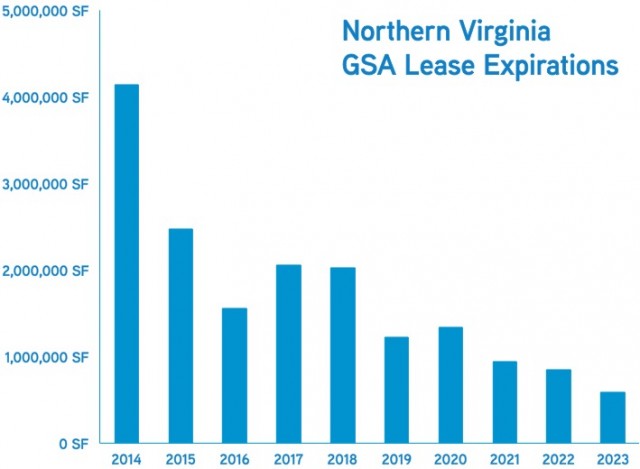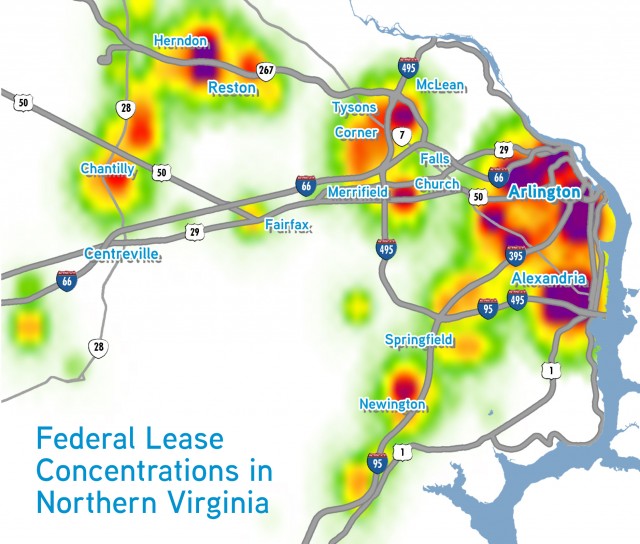This is a reprint of an article written for Northern Virginia NAIOP in April. To view it as it appeared in print, click here.
Northern Virginia houses to the second greatest concentration of federal government agencies in the United States. That is in large part due to its location directly across the Potomac River from the first most populous federal concentration, Washington, D.C. It is also because Northern Virginia is home to The Pentagon, headquarters of the Department of Defense (DoD).
As government agencies go, DoD is a good one to have. Its discretionary budget is $521 billion, which is more than all other federal agencies combined. In the decade following 9/11, no agency grew faster than DoD, especially if you factor in the intelligence agencies that operate under its supervision. Because of its massive budget, DoD also attracts a huge contractor tail. Its presence accounts for millions of square feet occupied by federal contractors across Northern Virginia.
But the market isn’t just about DoD. Northern Virginia is also home to the Department of State, the Patent and Trademark Office, FDIC, TSA and CIA, to name a few. The federal government has long provided a solid foundation for growth, especially benefitting the close-in submarkets. In the 10 years following 9/11, GSA-leased space in Northern Virginia grew by 5.4 MSF and today totals almost 21 MSF (not counting leases by independent federal agencies).
Yet, it is because Northern Virginia has been the beneficiary of so much federal largesse that it stands to bear the brunt of the federal government’s efforts to now reduce costs.
This article explores three trends that define the federal leasing market in Northern Virginia:
Kicking the Can
GSA has been engaged in a spirited game of can-kicking when it comes to leasing. Much of this has been due to intense budget distress from record deficits, rising debt, the sequester and a series of continuing resolutions, all cast against a backdrop of hopeless political dysfunction. Without long-term clarity of funding or mission, federal agencies have lapsed into triage mode, resulting in an increasing number of short-term extensions and holdovers.
These ever-shorter extensions have created a pile up of lease expirations such that nearly one-third of all GSA leases in Northern Virginia are due to expire this year and next. This is more than 6.6 MSF of leases (not counting holdovers) teetering on the verge of expiration. Worse yet, currently 1.5 MSF of leases are in their soft term.
From the government’s standpoint, this makes it an opportune time to quickly achieve its space reduction goals, yet GSA has been challenged to accomplish on-time completion of even the “normal” amount of leasing. In most years, some number of leases simply don’t get done and they are either extended for a short period or they lapse into holdover. In order to execute the next generation of leases, GSA will need to coordinate with its tenant agencies to plan consolidation, realignment and space reconfiguration. Each such project is a difficult and time consuming exercise and we can expect that thoughtful efforts could take years to execute. That means there will continue to be many more short-term leases and continued strain on GSA’s workload.
Budget stabilization will be the bellwether to indicate how quickly change will occur. The recent budget appropriations—the first since 2009—may embolden agencies to begin considering longer firm terms. Yet, when they do this, they will also seek to downsize and consolidate, which brings us to the next trend.

Reducing the Footprint
When it comes to the issue of real estate spending reduction, there is rare bipartisan agreement. Both Congress and the White House are clear on the goals: freeze the footprint, reduce costs and improve space utilization. These are the only three metrics of political importance. These trends are already happening though it isn’t yet fully apparent in market stats.
A good example is the recent U.S. Fish and Wildlife Service lease. That agency occupies a total of 258,000 RSF today in three Ballston buildings. Yet, when it relocates later this year to its new headquarters in Skyline, it will downsize to 183,000 RSF. Yes, that’s a 29% reduction. Not all agencies will shrink space so dramatically but, on the whole, downsizing will occur.
Where agencies ultimately seek to reduce or reconfigure their space, incumbent lessors could find themselves at a disadvantage. Executing renewals in those circumstances can require phased renovation, swing space and other logistical complications. GSA won’t always be willing to entertain this complexity, structuring its procurements to favor the blank canvas offered by competing vacant buildings.
With the incumbent’s pricing advantage eroded or eliminated, agencies are more likely to relocate, and opportunities for property developers and investors to be awarded new federal leases will be better than any time since before the recession. This will be perpetuated by the final macro trend: expansion of the delineated area.
Expanding the Delineated Area
In an effort to attract more competition and further reduce its costs, GSA has begun routinely competing its lease requirements throughout the entirety of Northern Virginia. GSA does not evaluate buildings the way that private-sector tenants do. Once it has been established that a building meets the basic technical requirements of the proposed lease GSA’s qualitative analysis ends there and it all comes down to price. Consider how unique this is: the federal government is perhaps the only tenant that views the Skyline and Eisenhower Avenue submarkets as genuine alternatives to Ballston (as Fish and Wildlife and the National Science Foundation did, respectively).
The locational factor that matters most is proximity to Metrorail, but even that can be structured loosely (the recent Fish and Wildlife lease only required that locations be within 5 miles of a Metro station). As a result, cost competition will make federal tenancy more mobile, increasingly pulling federal tenants further into the Northern Virginia suburbs. With the completion of the Silver Line, the competitive landscape will be significantly altered. Markets like Tysons Corner, Reston and Herndon will compete head-to-head with traditional federal locations in Arlington and Alexandria.
Expect change. It won’t happen suddenly, despite the towering wall of upcoming lease expirations. But as the federal budget stabilizes and GSA begins tackling the logistical issues relating to downsizing, the change will accelerate. Short of a significant policy shift, federal tenancy will decline and disperse. For existing lessors this presents challenges. For other property investors, this represents opportunity.

